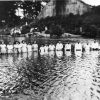calsfoundation@cals.org
Richard Nathaniel Hogan (1902–1997)
Richard Nathaniel Hogan was one of the most influential preachers and essayists among black Churches of Christ in the twentieth century.
Richard Hogan was born in Monroe County on November 30, 1902, the third child of Willie Hogan and Emma “Cathey” Hogan. He developed his skills as an orator and writer under the tutelage of George Philip Bowser, a black evangelist and educator from Tennessee. When Hogan was a child, his father died. He and his mother began living with her parents, who were devout members of the Church of Christ in Blackton (Monroe County). Perceiving few prospects for advancement or even secondary education in the racially oppressive Arkansas Delta, they allowed Hogan at age fourteen to move to Tennessee and enroll in Bowser’s Silver Point Christian Institute. Hogan excelled as a preacher, traveling with Bowser to revivals and becoming known as the “boy evangelist.”
Shortly before his eighteenth birthday, Hogan married Maggie Bullock. They had four children during a marriage that lasted more than seventy-five years, until her death in 1996. The young couple briefly lived in Tennessee before spending a year in Arkansas, moving to Louisville, Kentucky, and eventually making a home in Detroit, Michigan, following a pattern of black exodus from the South. Hogan worked in automobile factories for six years, “during which time,” he later wrote, “I allowed Satan to discourage me.” The labor provided for their growing family but ultimately displeased him. In 1930, he and his family moved to Chicago, Illinois, and started a church there, a move that launched his career as a full-time evangelist.
Hogan never again resided in Arkansas but visited on several occasions. In 1933, he helped establish two Churches of Christ in the state, one in Marvell (Phillips County) and another in Wabbaseka (Jefferson County). The latter was notable because it reflected the sectarianism that characterized Churches of Christ, whose members frequently railed against denominationalism and believed that they composed “the New Testament church.” Hogan recalled “taking the preacher, building and all of the members of a Christian Church” in Wabbaseka to create a new Church of Christ.
By the mid-1930s, Hogan and his family had moved to Muskogee, Oklahoma, and he was converting hundreds of people in summer revivals, including 189 at a 1934 revival in Okmulgee, Oklahoma. White Churches of Christ regularly sponsored Hogan as a means to establish a black Church of Christ in their towns. Thus, Hogan’s primary audiences and his converts were usually black, but his preaching also swayed many whites. Fourteen of the people who were converted at Okmulgee in 1934 were white, for example.
The inclusion of blacks and whites in a sectarian denomination created an unusual dynamic in an era when racial segregation was often legally codified, and Hogan faced occasional criticism from staunch segregationists who disliked his frequent interactions with whites. When white institutions among southern Churches of Christ resisted desegregation in the 1950s and 1960s, Hogan fiercely denounced them in the pages of the Christian Echo, a periodical founded by Bowser in 1902. Hogan had begun editing it in 1949 when his mentor’s health declined. At the same time, however, Hogan refused to participate in the civil rights activism that clergy from other denominations often engaged in.
Hogan supported a variety of efforts to provide educational opportunities to aspiring Church of Christ preachers. He trained numerous preachers in Oklahoma and later in California, where he and his family permanently moved in 1938. Hogan served on the board of directors of the Bowser Christian Institute in Fort Smith (Sebastian County) during its years of operation, 1938–1946. In 1948, he helped establish the Southern Bible Institute in Fort Worth, Texas, a school that moved to Terrell, Texas, the following year and became Southwestern Christian College. Hogan served on its board of directors for the rest of his life. He also created the Nigerian Foundation to provide financial assistance to native Nigerians who wished to attend Pepperdine College (now Pepperdine University) in Los Angeles, California.
After moving to California, Hogan continued to conduct revivals across the country until a heart attack slowed him in 1980. He helped start several Churches of Christ in California, including the Figueroa Church of Christ, which grew to have more than 1,000 members under his leadership. He served as its minister until his death on February 22, 1997. He is buried in Forest Lawn Memorial Park in Covina, California.
For additional information:
Boyd, R. Vernon. “Richard Nathaniel (R. N.) Hogan Interview—Transcript.” 1969. R. Vernon Boyd Collection Documents. Center for Restoration Studies. Abilene Christian University, Abilene, Texas. http://digitalcommons.acu.edu/vernon_boyd_docs/4 (accessed November 16, 2020).
Key, Barclay. “Civil Rights Inactivism: Richard Nathaniel Hogan and the ‘Enemies of Unrighteousness.’” In Race and Ethnicity in Arkansas: New Perspectives, edited by John A. Kirk. Fayetteville: University of Arkansas Press, 2014.
Hogan, Richard. Sermons by Hogan. Austin, TX: Firm Foundation, 1940.
Robinson, Edward J. Show Us How You Do It: Marshall Keeble and the Rise of Black Churches of Christ in the United States, 1914–1968. Tuscaloosa: University of Alabama Press, 2008.
Barclay Key
University of Arkansas at Little Rock
 Civil Rights and Social Change
Civil Rights and Social Change Religion
Religion World War II through the Faubus Era, 1941 through 1967
World War II through the Faubus Era, 1941 through 1967




Comments
No comments on this entry yet.